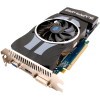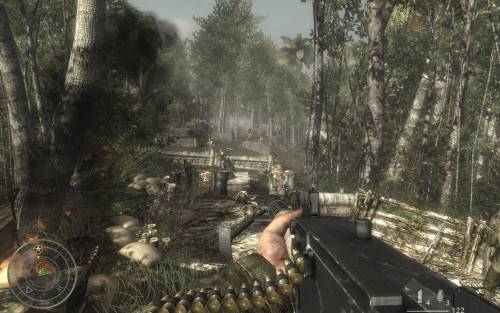- Qualcomm Launches Snapdragon 4 Gen 2 Mobile Platform
- AMD Launches Ryzen PRO 7000 Series Mobile & Desktop Platform
- Intel Launches Sleek Single-Slot Arc Pro A60 Workstation Graphics Card
- NVIDIA Announces Latest Ada Lovelace Additions: GeForce RTX 4060 Ti & RTX 4060
- Maxon Redshift With AMD Radeon GPU Rendering Support Now Available
Sapphire Radeon HD 4870 Vapor-X 2GB

Believe it or not, despite the HD 4890’s launch last month, the HD 4870 is still totally relevant, thanks to ATI’s current pricing structure. There’s a card for every budget, and if you’re willing to spend around $180, you can get hooked up with a 1GB version of the card we’re taking a look at today. It’s silent, keeps cool, and still delivers great performance for the money.
Page 3 – Call of Duty: World at War
While some popular game franchises are struggling to keep themselves healthy, Call of Duty doesn’t have much to worry about. This is Treyarch’s third go at a game in the series, and a first for one that’s featured on the PC. All worries leading up to this title were all for naught, though, as Treyarch delivered on all promises.
To help keep things fresh, CoD: World at War focuses on battles not exhaustively explored in previous WWII-inspired games. These include battles which take place in the Pacific region, Russia and Berlin, and variety is definitely something this game pulls off well, so it’s unlikely you’ll be off your toes until the end of the game.
For our testing, we use a level called “Relentless”, as it’s easily one of the most intensive levels in the game. It features tanks, a large forest environment and even a few explosions. This level depicts the Battle of Peleliu, where American soldiers advance to capture an airstrip from the Japanese. It’s a level that’s both exciting to play and one that can bring even high-end systems to their knees.
Note: Before we dive into the results, I’d like to point out that both ATI’s drivers and the games being tested have been updated since we last benchmarked our 1GB HD 4870. Therefore, the card we’re taking a look at today is going to pull ahead for those reasons. This is important, because in our graphs, it looks as though the 2GB card is the reason for the better performance, but in reality, the 1GB model will perform roughly the same with the latest drivers (we conducted quick tests to verify this). So please just bear that in mind.



Compared to the rest of our GPU lineup, the HD 4870 is beginning to look a bit outdated. That’s not so much the case though, since all of the cards that rank above it is more expensive, with the exception of NVIDIA’s GTX 260/216 which hovers around an identical price-point.
|
Graphics Card
|
Best Playable
|
Avg. FPS
|
|
NVIDIA GTX 295 1792MB x 2
|
2560×1600 – Max Detail, 8xAA
|
90.283 FPS
|
|
NVIDIA GTX 285 1GB x 2
|
2560×1600 – Max Detail, 8xAA
|
63.401 FPS
|
|
Zotac GTX 295 1792MB
|
2560×1600 – Max Detail, 8xAA
|
52.461 FPS
|
|
Palit HD 4870 X2 2GB
|
2560×1600 – Max Detail, 8xAA
|
37.825 FPS
|
|
NVIDIA GTX 285 1GB
|
2560×1600 – Max Detail, 4xAA
|
41.510 FPS
|
|
NVIDIA GTX 275 896MB
|
2560×1600 – Max Detail, 4xAA
|
39.998 FPS
|
|
Palit GTX 280 1GB
|
2560×1600 – Max Detail, 4xAA
|
38.192 FPS
|
|
Sapphire HD 4890 1GB
|
2560×1600 – Max Detail, 4xAA
|
34.094 FPS
|
|
XFX GTX 260/216 896MB
|
2560×1600 – Max Detail, 4xAA
|
32.723 FPS
|
|
Sapphire HD 4870 2GB
|
2560×1600 – Max Detail, 4xAA
|
30.409 FPS
|
|
ASUS GeForce 9800 GTX+ 512MB
|
2560×1600 – Max Detail, 0xAA
|
34.596 FPS
|
|
NVIDIA GeForce GTS 250 1GB
|
2560×1600 – Max Detail, 0xAA
|
34.192 FPS
|
|
Diamond HD 4870 1GB
|
2560×1600 – Max Detail, 0xAA
|
30.372 FPS
|
|
Sapphire HD 4830 512MB
|
1920×1200 – Max Detail, 0xAA
|
40.157 FPS
|
|
Sapphire HD 4670 512MB
|
1920×1200 – Max Detail, 0xAA
|
28.101 FPS
|
For most FPS titles, I tend to say that 30 frames per second is the bare-minimum, so we’re cutting it close here. However, although at times the game dipped below 30 FPS, I still found it to be extremely playable, and I personally wouldn’t hesitate to play through the entire thing like that. However, if you prefer higher FPS over anti-aliasing, disabling it is a quick fix. At this ultra-high resolution, AA is not missed too much, especially in the heat of battle.
Support our efforts! With ad revenue at an all-time low for written websites, we're relying more than ever on reader support to help us continue putting so much effort into this type of content. You can support us by becoming a Patron, or by using our Amazon shopping affiliate links listed through our articles. Thanks for your support!






